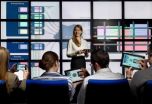(Press-News.org) The tiny, little-noticed jewel wasp may provide some answers as to how different species differ in size and shape. And that could lead to a better understanding of cell growth regulation, as well as the underlying causes of some diseases.
Using the wings of these insects as a tool to study how growth is regulated, biologists at the University of Rochester have discovered that changes in expression of a well-known cell regulator gene called "unpaired" (upd) accounts for wing growth differences between males of closely related species. Unpaired is distantly related to a class of genes called "interleukins'" which affect cell growth and specialization in humans. The discovery illustrates the principle that animals—from insects to humans—often use the same "genetic toolkit," despite immense differences in their biology. The findings are being published in the current issue of the journal Science.
Prof. John (Jack) Werren and doctoral student David Loehlin isolated the gene causing the wing difference through a technique called positional cloning. The large-winged N. giraulti and small-winged N. vitripennis wasps were crossbred, resulting in hybrid wasps with mixed chromosomes. Afterwards, the offspring with the largest wings were crossbred with pure N. vitripennis wasps, until, after ten generations, Werren and Loehlin had pure N. vitripennis wasps, with one exception: The young wasps now had DNA for large wings. They then used the same method to "break" the isolated genetic material into parts, in order to investigate how DNA flanking the gene affected its regulation and growth of the wings.
"The NIH had already supported sequencing of the genomes of the wasps, so we had the necessary tools to do the work," said Werren. Specifically, Werren and Loehlin found that the change in wing size wasn't due to the gene, but to the regulation of the gene.
"The DNA sequence next to the gene controls where in the wing the gene is turned on or off," said Loehlin, the first author of the research project. "This is one of the first cases where scientists have found genetic material responsible for naturally-occurring growth differences in animals."
Normal growth regulation is also required for an animal to develop, and inappropriate regulation of growth causes disease, including cancer. "This work is another clear example that regulating the activity of genes contributes to the incredible diversity of life on Earth," said Susan Haynes, Ph.D., who oversees developmental biology grants at the National Institutes of Health's National Institute of General Medical Sciences, which partially funded the work. "In this case, modulating the activity of a gene for cell growth reshapes and resizes a wasp's wing. Because insects and humans use similar genetic networks to create organs, this research could help us better understand our own development and the underlying causes of certain diseases."
Nasonia are emerging as a model insect for research because the male wasps are haploid, which means they have only one set of chromosomes, while the females are diploid, having two sets of chromosomes. Since a single gene in a male wasp controls a given trait—without consideration for whether that gene is dominant or recessive—the result is that physical changes to the male wasps showed up more quickly from one generation to the next.
INFORMATION:
Researchers find a key to growth differences between species
2012-02-24
ELSE PRESS RELEASES FROM THIS DATE:
Researchers discover how vitamin D inhibits inflammation
2012-02-24
Researchers at National Jewish Health have discovered specific molecular and signaling events by which vitamin D inhibits inflammation. In their experiments, they showed that low levels of Vitamin D, comparable to levels found in millions of people, failed to inhibit the inflammatory cascade, while levels considered adequate did inhibit inflammatory signaling. They reported their results in the March 1, 2011, issue of The Journal of Immunology.
"This study goes beyond previous associations of vitamin D with various health outcomes. It outlines a clear chain of cellular ...
Higher risk of autism among certain immigrant groups
2012-02-24
A major register study from the Swedish medical university Karolinska Institutet shows that children born to certain groups of immigrants in Sweden had an increased risk of developing autism with intellectual disability. The study includes all children in Stockholm County from 2001 to 2007, and brings the question of the heredity of autism to the fore.
"This is an intriguing discovery, in which we can see strong links between a certain kind of autism and the time of the mother's immigration to Sweden," says principal investigator Cecilia Magnusson, Associate Professor ...
How 1-year-olds can recognize beliefs of others
2012-02-24
Prof. Dr. Albert Newen and Dr. Leon de Bruin from the Institute of Philosophy II at the Ruhr-Universität explain their theory in the journal Cognition. In the first year of life, children already have a basic "theory of mind", that is, they are capable of distinguishing their own beliefs from those of others. At the age of four, this capacity is fully developed. According to the Bochum model, this development is guided by two interacting systems.
Contradictory results: "false belief" test with and without language
The test: Sally puts her ball into a basket and goes ...
Parkinson's disease patients can become more creative when they take dopamine
2012-02-24
Some Parkinson's Disease patients can suddenly become creative when they take dopamine therapy, producing pictures, sculptures, novels and poetry. But their new-found interests can become so overwhelming that they ignore other aspects of their everyday life, such as daily chores and social activities, according to research published in the March issue of the European Journal of Neurology.
Italian researchers studied 36 patients with Parkinson's Disease - 18 with increased artistic production and 18 without - and compared them with 36 healthy controls without Parkinson's. ...
Cebit 2012 -- Internet service prevents cable tangle in presentations at conferences
2012-02-24
To connect a laptop to an additional monitor, projector or even to a monitor wall, a special cable was required, until now. Researchers of the Saarland University's Intel Visual Computing Institute overcome this obstacle by linking computer and monitor via an 'Internet Service'. By this means, a screen's contents can be shifted freely to any terminal's display and even shown on large-scale monitor walls. The Saarland University's scientists present their results for the first time at stand F34, in hall 9 at the computer fair Cebit. The trade show takes place in Hannover ...
Fear of job loss causes dissatisfaction and a lack of commitment at work
2012-02-24
A study in Spain shows that insecurity at work is directly and negatively linked to satisfaction in work and life, as well as affecting performance and commitment. Furthermore, the research reveals that the consequences of this insecurity are different according to the occupational group they work in.
A study led by Spanish psychologists has concluded that the feeling that one is going to lose their job worsens satisfaction levels in other areas of life, such as family, health, financial circumstances and the work-free time balance.
As the fear of unemployment increases ...
First study to show that bisphenol A exposure increases risk of future onset of heart disease
2012-02-24
Bisphenol A (BPA) is a controversial chemical widely used in the plastics industry. A new study followed people over a 10-year time period and shows that healthy people with higher urine concentrations of BPA were more likely to later develop heart disease.
The study was carried out by researchers at the Peninsula College of Medicine and Dentistry, the University of Exeter and the European Centre for the Environment and Human Health, in association with the University of Cambridge. The analysis was funded by the British Heart Foundation. The paper is published online ...
Exclusive interview with lead spacewalker on Endeavour's final mission
2012-02-24
In an exclusive interview with Physics World, astronaut Drew Feustel gives a vivid account of his two missions into space and recalls his determination to make his childhood ambition – space flight – come true.
In the video, Feustel discusses his two missions – his maiden flight in 2009, as part of a team sent to repair the Hubble Space telescope, and his return to space in 2011 as the lead spacewalker on Endeavour's final mission to the International Space Station.
Recalling the first moments of launch, when you're sitting on the launch pad and the countdown hits ...
Recalling items from memory reduces our ability to recall other related items
2012-02-24
Researchers at the universities of Granada and Jaén, Spain, have discovered why recalling some items from memory reduces our ability to recall other related items. In the field of Psychology, this phenomenon is known as "Retrieval-Induced Forgetting" (RIF), and researchers have determined the cognitive process that causes this phenomenon and its duration.
To carry out this study, the researchers designed a set of memory tasks where the participants had to learn a material and then recall it partially. Memory tasks had different levels of difficulty and included different ...
World nourishment at risk of being diminished: Wild cereals threatened by global warming
2012-02-24
A 28-year comparative study of wild emmer wheat and wild barley populations has revealed that these progenitors of cultivated wheat and barley, which are the best hope for crop improvement, have undergone changes over this period of global warming. The changes present a real concern for their being a continued source of crop improvement.
Wheats and barleys are the staple food for humans and animal feed around the world, and their wild progenitors have undergone genetic changes over the last 28 years that imply a risk for crop improvement and food production, reveals a ...



